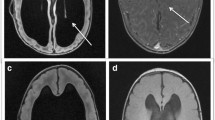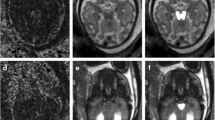Abstract
Purpose
To investigate white matter microstructural abnormality based on diffusion tensor imaging (DTI) in pediatric patients with fetal repair for myelomeningocele (MMC).
Methods
This was a retrospective analysis of DTI data from 8 pediatric patients with prenatal MMC repair (age range 1.64–33.70 months; sex 3F/5M) and 8 age-matched controls (age 2.24–31.20 months; sex 5F/2M). All participants were scanned on 1.5T GE Signa MR scanner (GE Healthcare, Milwaukee, WI) with the same sequence specifications. Two DTI measures, including fractional anisotropy (FA) and mean diffusivity (MD), were calculated from the genu of corpus callosum (gCC) and the posterior limb of internal capsule (PLIC). DTI values and fronto-occipital horn ratio (FOHR) were tested for group difference based on two-tailed paired t test.
Results
The ventricle size based on FOHR in patients with prenatal MMC repair was significantly larger than that in the age-matched control group (p < 0.001). Statistically significant group difference in DTI (lower FA and higher MD in patient group) was found in gCC (p = 0.007 and 0.003, respectively). A trend level increase in MD was also found (p = 0.065) in PLIC in patients when compared with the age-matched controls.
Conclusion
Our data showed white matter abnormality based on DTI in pediatric patient with fetal repair for MMC. The sensitivity of DTI in detecting white matter abnormality, as shown in the present study, may help to serve as an imaging biomarker for assessing hydrocephalus and improve and optimize decision making for the treatment of hydrocephalus in this patient population.



Similar content being viewed by others
References
Adzick NS, Thom EA, Spong CY, Brock JW 3rd, Burrows PK, Johnson MP, Howell LJ, Farrell JA, Dabrowiak ME, Sutton LN, Gupta N, Tulipan NB, D’Alton ME, Farmer DL, Investigators M (2011) A randomized trial of prenatal versus postnatal repair of myelomeningocele. N Engl J Med 364:993–1004
Air EL, Yuan W, Holland SK, Jones BV, Bierbrauer K, Altaye M, Mangano FT (2010) Longitudinal comparison of pre- and postoperative diffusion tensor imaging parameters in young children with hydrocephalus. J Neurosurg Pediatr 5:385–391
Beaulieu C (2002) The basis of anisotropic water diffusion in the nervous system - a technical review. NMR Biomed 15:435–455
Bowman RM, McLone DG, Grant JA, Tomita T, Ito JA (2001) Spina bifida outcome: a 25-year prospective. Pediatr Neurosurg 34:114–120
Bowman RM, Boshnjaku V, McLone DG (2009) The changing incidence of myelomeningocele and its impact on pediatric neurosurgery: a review from the Children’s Memorial Hospital. Childs Nerv Syst 25:801–806
Cancelliere A, Mangano FT, Air EL, Jones BV, Altaye M, Rajagopal A, Holland SK, Hertzler DA 2nd, Yuan W (2013) DTI values in key white matter tracts from infancy through adolescence. AJNR Am J Neuroradiol 34:1443–1449
Eskandari R, Abdullah O, Mason C, Lloyd KE, Oeschle AN, McAllister JP 2nd (2014) Differential vulnerability of white matter structures to experimental infantile hydrocephalus detected by diffusion tensor imaging. Childs Nerv Syst 30:1651–1661
Hasan KM, Eluvathingal TJ, Kramer LA, Ewing-Cobbs L, Dennis M, Fletcher JM (2008) White matter microstructural abnormalities in children with spina bifida myelomeningocele and hydrocephalus: a diffusion tensor tractography study of the association pathways. J Magn Reson Imaging 27:700–709
Jang SH, Choi BY, Chang CH, Jung YJ, Byun WM, Kim SH, Yeo SS (2013) The effects of hydrocephalus on the periventricular white matter in intracerebral hemorrhage: a diffuser tensor imaging study. Int J Neurosci 123:420–424
Jiang H, van Zijl PC, Kim J, Pearlson GD, Mori S (2006) DtiStudio: resource program for diffusion tensor computation and fiber bundle tracking. Comput Methods Prog Biomed 81:106–116
Kim I, Hopson B, Aban I, Rizk EB, Dias MS, Bowman R, Ackerman LL, Partington MD, Castillo H, Castillo J, Peterson PR, Blount JP, Rocque BG (2018) Treated hydrocephalus in individuals with myelomeningocele in the National Spina Bifida Patient Registry. J Neurosurg Pediatr 22:646–651
Kulkarni AV, Donnelly R, Mabbott DJ, Widjaja E (2015) Relationship between ventricular size, white matter injury, and neurocognition in children with stable, treated hydrocephalus. J Neurosurg Pediatr 16:267–274
Mangano FT, Altaye M, McKinstry RC, Shimony JS, Powell SK, Phillips JM, Barnard H, Limbrick DD Jr, Holland SK, Jones BV, Dodd J, Simpson S, Mercer D, Rajagopal A, Bidwell S, Yuan W (2016) Diffusion tensor imaging study of pediatric patients with congenital hydrocephalus: 1-year postsurgical outcomes. J Neurosurg Pediatr 18:306–319
O’Hayon BB, Drake JM, Ossip MG, Tuli S, Clarke M (1998) Frontal and occipital horn ratio: a linear estimate of ventricular size for multiple imaging modalities in pediatric hydrocephalus. Pediatr Neurosurg 29:245–249
Sanz Cortes M, Torres P, Yepez M, Guimaraes C, Zarutskie A, Shetty A, Hsiao A, Pyarali M, Davila I, Espinoza J, Shamshirsaz AA, Nassr A, Whitehead W, Lee W, Belfort MA (2019) Comparison of brain microstructure after prenatal spina bifida repair by either laparotomy assisted fetoscopic or open approach. Ultrasound Obstet Gynecol. https://doi.org/10.1002/uog.20373
Simon TD, Riva-Cambrin J, Srivastava R, Bratton SL, Dean JM, Kestle JR, Hydrocephalus Clinical Research N (2008) Hospital care for children with hydrocephalus in the United States: utilization, charges, comorbidities, and deaths. J Neurosurg Pediatr 1:131–137
Tulipan N, Wellons JC 3rd, Thom EA, Gupta N, Sutton LN, Burrows PK, Farmer D, Walsh W, Johnson MP, Rand L, Tolivaisa S, D’Alton ME, Adzick NS, Investigators M (2015) Prenatal surgery for myelomeningocele and the need for cerebrospinal fluid shunt placement. J Neurosurg Pediatr 16:613–620
Ware AL, Juranek J, Williams VJ, Cirino PT, Dennis M, Fletcher JM (2014) Anatomical and diffusion MRI of deep gray matter in pediatric spina bifida. Neuroimage Clin 5:120–127
Yuan W, Mangano FT, Air EL, Holland SK, Jones BV, Altaye M, Bierbrauer K (2009) Anisotropic diffusion properties in infants with hydrocephalus: a diffusion tensor imaging study. AJNR Am J Neuroradiol 30:1792–1798
Yuan W, McKinstry RC, Shimony JS, Altaye M, Powell SK, Phillips JM, Limbrick DD Jr, Holland SK, Jones BV, Rajagopal A, Simpson S, Mercer D, Mangano FT (2013) Diffusion tensor imaging properties and neurobehavioral outcomes in children with hydrocephalus. AJNR Am J Neuroradiol 34:439–445
Yuan W, Holland SK, Shimony JS, Altaye M, Mangano FT, Limbrick DD, Jones BV, Nash T, Rajagopal A, Simpson S, Ragan D, McKinstry RC (2015) Abnormal structural connectivity in the brain networks of children with hydrocephalus. Neuroimage Clin 8:483–492
Funding
This study is supported in part by the Robert L. McLaurin, MD, Research Fund in Neurosurgery at Cincinnati Children’s Hospital Medical Center.
Author information
Authors and Affiliations
Corresponding author
Ethics declarations
Conflict of interest
Authors associated with this submission have no financial conflicts of interest to disclose.
Additional information
Publisher’s note
Springer Nature remains neutral with regard to jurisdictional claims in published maps and institutional affiliations.
Electronic supplementary material
ESM 1
(DOCX 11 kb)
Rights and permissions
About this article
Cite this article
Mangano, F.T., Stevenson, C.B., Nagaraj, U. et al. Abnormal anisotropic diffusion properties in pediatric myelomeningocele patients treated with fetal surgery: an initial DTI study. Childs Nerv Syst 36, 827–833 (2020). https://doi.org/10.1007/s00381-019-04339-1
Received:
Accepted:
Published:
Issue Date:
DOI: https://doi.org/10.1007/s00381-019-04339-1




